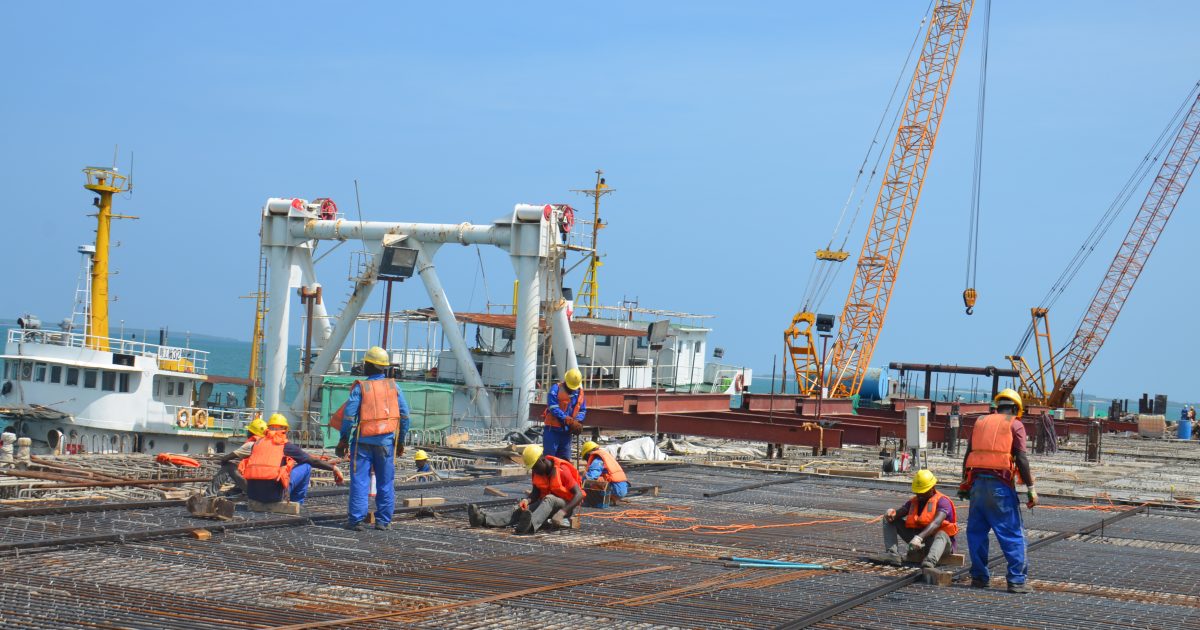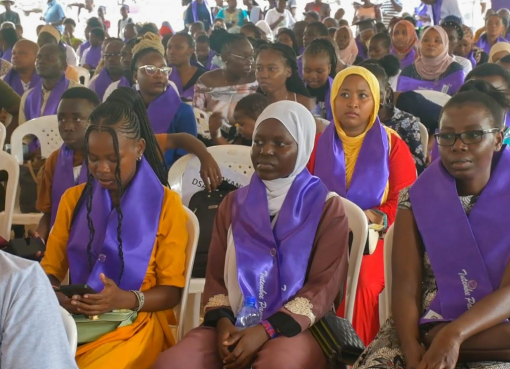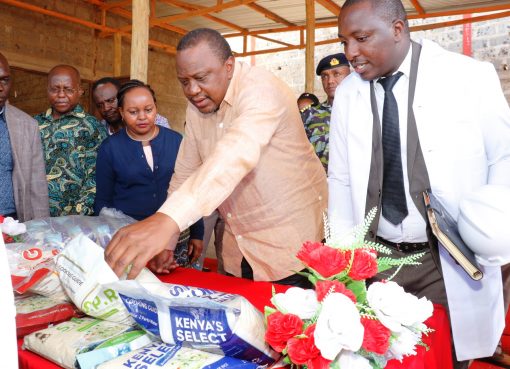Chinese contractor building Lamu Port will soon complete the construction of the first three berths of the flagship Vision 2030 project at Kililana.
According to Kenya Ports Authority (KPA) engineers interviewed at the site, the China Communication Construction Company (CCCC) has finished 62 per cent of the work on the three berths and will handover to the government and KPA by the end of 2019.
A visit to the construction site revealed that the contractor is making steady progress with the construction of the first three berths for the new commercial Lamu seaport which was launched in 2012 by retired President Mwai Kibaki, the late Ethiopian Prime Minister Ato Meles Zenawi and South Sudan President Salvar Kiir Mayardit.
The port is being built at Manda Bay, which juts out towards the islands of Pate, Manda and Lamu and the location is chosen for its size and deep waters capable of accommodating jumbo-sized ships.
The port facility which will serve landlocked Ethiopia,South Sudan and Northern Kenya has been hailed by Lamu leaders and residents as a game changer in the economic dynamics of the Kenya’s north Coast and the region as a whole. The leaders said the impact of the port investment so far has seen the creation of new businesses, jobs and workspaces.
Maritime experts see the grandiose modern port of Lamu dubbed Lamu South Sudan Ethiopia Transport (LAPPSET) corridor as a catalyst to position Kenya as a key transshipment and maritime hub.
LAPSSET is a crucial Kenya Vision 2030 flagship project and is expected to transform regional economies through increased trade, integration and inter-connectivity spanning South Sudan and landlocked Ethiopia.
Kenya vision 2030 strategy is the national long-term development policy that aims to transform the country into a newly industrializing, middle-income country providing high quality of life to all citizens by 2030 in a clean and secure environment.
The new transport corridor seeks to link the modern port of Lamu with Garissa, Isiolo, Maralal, Lodwar and Lokichogio and branching at Isiolo to Moyale at the border with Ethiopia and proceeding to the border with South Sudan.
According to Eng. Jimmy Tuqida, the deputy Lamu port project manager, the development of the three berths at the more sheltered Manda Bay is crucial for the importation of building materials for the other project components.
Engineer Tuqida said the mega port will position Lamu as an important trans-shipment hub and is poised to handle crude and refined oil and oil products from South Sudan and has the potential to impact on the livelihoods of citizens of Kenya, Ethiopia and South Sudan.
During the groundbreaking ceremony of the Lapsset project in 2012 retired President Mwai Kibaki, the late Ethiopian Prime Minister Ato Meles Zenawi and South Sudan president Salva Kiir graced the occasion.
A tour of the ultra-modern state-of-the-art port facility show that over 60 percent of the Lapsset berths is completed as the contractor on site is working with speed to meet the deadlines set.
In an interview with the Kenya News Agency on Friday, Eng. Tuqida said Manda Bay was selected because it has deep and sheltered bay and a wide navigable entrance channel for larger vessels, increased container handling capacity and general productivity.
Eng. Tuqida said the multi-billion port project which he termed as the largest port in East and Central Africa is taking shape at an unparalleled speed and is over 62 per cent complete four years after work began on it.
‘The new port is slated to commence operations in 2020 when the first three berths out of the planned 32 berths would be completed’, he said at the new port site while assessing the progress of the project.
The port engineer said in the long run, the transport corridor will comprise a standard gauge railway line, oil pipeline and refinery, road network, international airports and resort cities.
Eng. Tuqida says 855 Kenyans including 13 engineers and 150 Chinese nationals are working round the clock to deliver the strategic project within the stipulated time frame.
‘The project is already enhancing business experiences, skills training and job opportunities for the local population’ he said.
He said that Kenya is wholly financing the construction of the first three berths with the rest expected to be financed by the private sector under a public private sector framework.
“The national government is set to invite private investors to bid for the construction of the remaining 29 proposed berths along the ocean coastline”, said the engineer.
He said the first three berths which are expected to be in operation in 2020 will handle 1.2 million TEUs (twenty-foot equivalent units) and when fully operational will handle 20 million TEUs.
The berths will be capable of handling crude oil carriers with dead weight tonnage of up to 200,000 tones and a capacity of two million barrels of crude.
Eng. Tuqida also said dredge works are well underway at the proposed Lamu port and the excavated materials from the sea-bed are being re-used in the construction of container storage and stacking yards.
He said the contractor is currently dredging the quayside and deepening the berths to 17.5 meters to enable the new port to handle post-panamax ships from the global shipping lines.
The port contractor emphasized that bigger vessel size means lower cost for trade enabling Kenya’s competitiveness globally and it will ultimately drive growth and employment.
He said in order to maintain a clear access for ships, ports are regularly dredged.
Kenya Ports Authority (KPA) which is scheduled to run operations of the new port has already built a state-of-the-art Lamu port headquarters at Killilana.
The authority is now busy building modern housing units to cater for KPA staff who will be deployed to work in Lamu once the construction of the three government funded berths is completed.
Other major developments at the port side include a port police station, electric power line connected to the national grid and water supply to the port.
Lamu deputy governor Abdulhakim Aboud Bwana says the huge port project is a ‘unique opportunity’ to transform Lamu into a key port town.
Bwana said with the unfolding LAPPSET projects Lamu is undergoing a period of rapid change which will see thousands of jobs created and millions of shillings invested into the local economy.
He noted that the LAPSSET project is destined to attract more businesses and bring in jobs, tourists and money besides diversifying the economic activity at the historic Lamu archipelago which is a Unesco World Heritage Site.
Mr. Bwana said the Lamu port has the potential to completely transform the economic status of the entire coast region with increased employment opportunities and better social amenities.
He expressed optimism that the new port would lead to the development of infrastructure in the tourist resort town of Lamu and enhance the lives of the island dwellers.
The deputy governor at the same time welcomed the confirmation of Dr. Daniel Manduku as the substantive KPA MD noting that under his watch port performance has improved and staff motivated.
He said Dr. Manduku has pledged to work closely with the county government, local leadership and island dwellers that he said are an important part of the port community.
By Mohamed Hassan
Three berths out of 32 at LAPSSET Lamu port now 62 percent complete





